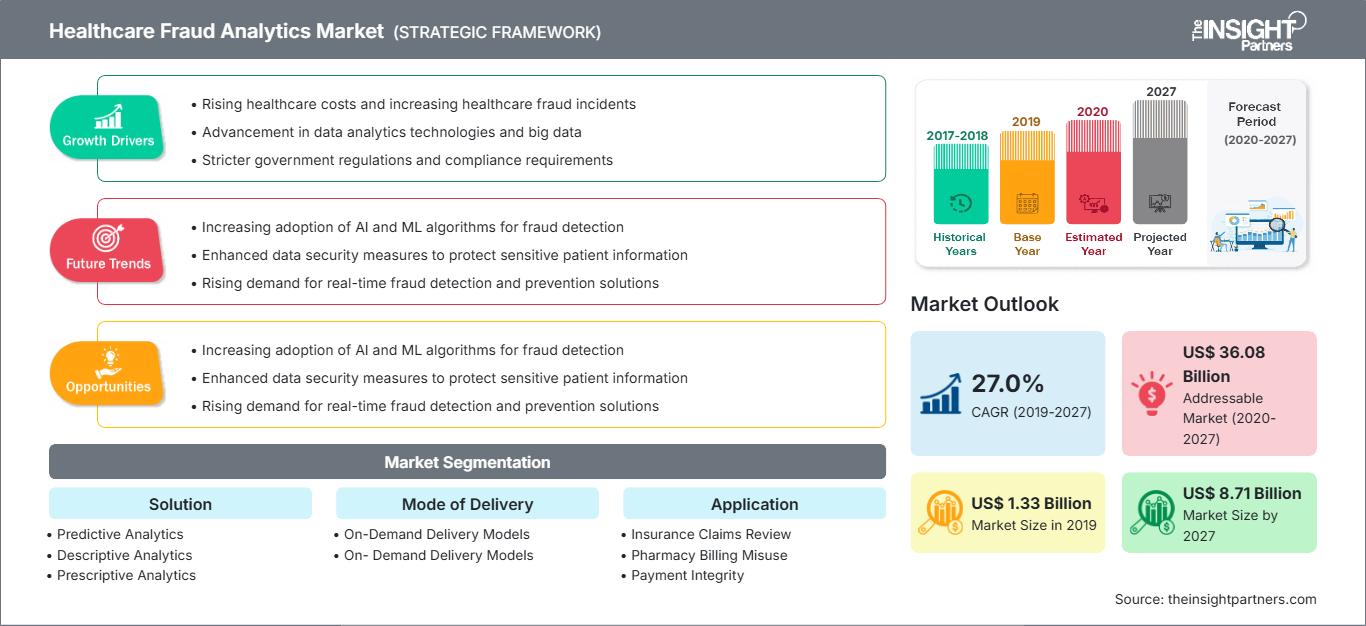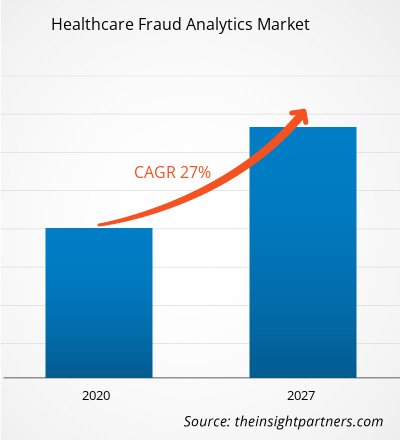El mercado de análisis de fraude atención en médica se valoró en US$ 1.331,09 millones en 2019 y se proyecta que alcance los US$ 8.707,73 millones en 2027; se espera que crezca a una CAGR del 27,0% entre 2020 y 2027.
El fraude sanitario es un tipo de delito de cuello blanco que incluye la presentación de reclamaciones fraudulentas de atención médica para obtener ganancias. La mayor parte del fraude sanitario es cometida por grupos del crimen organizado y una pequeña minoría de proveedores de atención médica fraudulenta. Los tipos más comunes de fraude sanitario incluyen la facturación de servicios o procedimientos más costosos, la tergiversación de tratamientos no cubiertos, los fraudes de seguros y otros. El crecimiento del mercado global de análisis de fraude sanitario se atribuye al creciente número de casos de fraude en todos los sectores y al crecimiento de la industria de seguros médicos en EE.UU. UU. Sin embargo, la preocupación por el análisis de fraude sanitario es el principal factor que frena el crecimiento del mercado.
Se prevé un crecimiento sustancial del mercado global de análisis de fraude en el sector sanitario tras la pandemia. La COVID-19 ha afectado a las economías e industrias de varios países debido a confinamientos, prohibiciones de viaje y cierres de empresas. La crisis de la COVID-19 ha sobrecargado los sistemas de salud pública en muchos países y ha puesto de aliviar la gran necesidad de inversión sostenible en ellos. A medida que la pandemia de COVID-19 avanza, se prevé una caída del crecimiento en el sector sanitario. El sector de las ciencias de la vida prospera gracias a la mayor demanda de productos de diagnóstico in vitro y al aumento de las actividades de investigación y desarrollo a nivel mundial. Sin embargo, el sector de las tecnologías médicas y la imagenología está experimentando una caída de las ventas debido a la menor cantidad de cirugías realizadas y los retrasos o prolongaciones en la adquisición de equipos. Además, se prevé que las consultas virtuales de profesionales sanitarios se convertirán en el modelo de atención sanitaria general tras la pandemia. Con la telesalud transformando la atención sanitaria, la salud digital seguirá prosperando en los próximos años. Asimismo, se prevé que la interrupción de los ensayos clínicos y el consiguiente retraso en el lanzamiento de fármacos allanen el camino para ensayos totalmente virtuales en el futuro. Se espera que surjan nuevas tecnologías como el ARNm y transformen la industria farmacéutica y el mercado; También se espera que sea testigo de una mayor integración vertical y empresas conjuntas en los próximos años.
Personalice este informe según sus necesidades
Obtendrá personalización en cualquier informe, sin cargo, incluidas partes de este informe o análisis a nivel de país, paquete de datos de Excel, así como también grandes ofertas y descuentos para empresas emergentes y universidades.
Análisis del mercado del fraude sanitario: perspectivas estratégicas

-
Obtenga las principales tendencias clave del mercado de este informe.Esta muestra GRATUITA incluye análisis de datos, desde tendencias del mercado hasta estimaciones y pronósticos.
Perspectivas del mercado
El crecimiento de la industria de seguros de salud en EE. UU. impulsará el crecimiento del mercado mundial de análisis de fraudes en la atención médica.
El fraude en seguros médicos es un engaño deliberado cometido contra una compañía o agente de seguros para obtener un beneficio económico. Los fraudes se cometen en diferentes etapas de la transacción por parte de solicitantes, asegurados, terceros reclamantes o profesionales de la salud que prestan servicios a los reclamantes. En ocasiones, los agentes de seguros, así como los empleados de la compañía, también pueden cometer fraude. Los fraudes más comunes en seguros médicos incluyen la manipulación de reclamaciones legítimas, la exageración de los datos en una solicitud de seguro, la presentación de reclamaciones por enfermedades o lesiones que nunca ocurrieron y la simulación de accidentes.
En Estados Unidos, existen más de 900 compañías de seguros médicos que ofrecen cobertura médica. Además, la cantidad de personas con seguro médico en el país es alta. Según el informe "Cobertura de Seguro Médico en Estados Unidos: 2018", en ese año, aproximadamente el 91,5 % de la población contaba con seguro médico. El informe también mencionó que, en 2018, la cobertura de seguro médico privado era más frecuente en EE. UU. que la cobertura pública: aproximadamente el 67,3 % de la población tenía seguro médico privado y el 34,4 % tenía cobertura pública. Entre los subtipos, el seguro médico a través del empleador fue el más común, representando el 55,1 % de la población.
Debido al crecimiento de la industria de seguros de salud y al creciente número de fraudes en seguros de salud, se espera que la demanda de soluciones de análisis de fraude en la atención médica aumente durante el período de pronóstico.
Perspectivas basadas en soluciones
En términos de soluciones, el mercado global de análisis de fraude en atención médica se segmenta en análisis predictivo, análisis descriptivo y análisis prescriptivo. En 2019, el segmento de análisis predictivo tuvo la mayor participación de mercado. Además, se estima que este mismo segmento registrará la mayor tasa de crecimiento anual compuesta (TCAC) durante el período de pronóstico.
Perspectivas basadas en el modo de entrega
Según el modo de prestación, el mercado global de análisis de fraude en atención médica se segmenta en modelos de prestación local y modelos de prestación en la nube. El segmento de modelos de prestación local tuvo la mayor cuota de mercado en 2019. Sin embargo, se estima que el segmento de modelos de prestación en la nube registrará la mayor tasa de crecimiento anual compuesta (TCAC) durante el período de pronóstico.
Perspectivas basadas en aplicaciones
Según la aplicación, el mercado global de análisis de fraudes en la atención médica se segmenta en revisión de reclamaciones de seguros, uso indebido de la facturación farmacéutica, integridad de pagos, robo de identidad médica y otras aplicaciones. El segmento de reclamaciones de seguros tuvo la mayor cuota de mercado en 2019. Además, se estima que este mismo segmento registrará la mayor tasa de crecimiento anual compuesta (TCAC) durante el período de pronóstico.
Información basada en el usuario final
En términos de usuario final, el mercado global de análisis de fraude en atención médica se segmenta en agencias gubernamentales, aseguradoras privadas, proveedores de servicios externos y empleadores. El segmento de agencias gubernamentales tuvo la mayor participación de mercado en 2019, y se estima que este mismo segmento registrará la mayor tasa de crecimiento anual compuesta (TCAC) durante el período de pronóstico.
Los actores del mercado global de análisis de fraude en atención médica están adoptando estrategias de lanzamiento y expansión de productos para satisfacer las cambiantes demandas de los clientes en todo el mundo, lo que también les permite mantener su marca a nivel mundial.
Análisis del mercado del fraude en la atención médica: perspectivas regionales
Los analistas de The Insight Partners han explicado detalladamente las tendencias y los factores regionales que influyen en el mercado de análisis de fraude en la atención médica durante el período de pronóstico. Esta sección también analiza los segmentos y la geografía del mercado de análisis de fraude en la atención médica en América del Norte, Europa, Asia Pacífico, Oriente Medio y África, y América del Sur y Central.
Alcance del informe de mercado sobre análisis de fraude en la atención médica
| Atributo del informe | Detalles |
|---|---|
| Tamaño del mercado en 2019 | 1.330 millones de dólares estadounidenses |
| Tamaño del mercado en 2027 | US$ 8.71 mil millones |
| CAGR global (2019-2027) | 27,0% |
| Datos históricos | 2017-2018 |
| Período de pronóstico | 2020-2027 |
| Segmentos cubiertos |
Por solución
|
| Regiones y países cubiertos |
América del norte
|
| Líderes del mercado y perfiles de empresas clave |
|
Densidad de actores del mercado de análisis de fraude en atención médica: comprensión de su impacto en la dinámica empresarial
El mercado de análisis de fraude en la atención médica está creciendo rápidamente, impulsado por la creciente demanda de los usuarios finales debido a factores como la evolución de las preferencias de los consumidores, los avances tecnológicos y un mayor conocimiento de los beneficios del producto. A medida que aumenta la demanda, las empresas amplían su oferta, innovan para satisfacer las necesidades de los consumidores y aprovechan las tendencias emergentes, lo que impulsa aún más el crecimiento del mercado.

- Obtenga una descripción general de los principales actores clave del mercado de análisis de fraude en atención médica
Mercado global de análisis de fraudes en la atención médica: por solución
- Análisis predictivo
- Análisis descriptivo
- Análisis prescriptivo
Mercado global de análisis de fraudes en la atención médica: por modalidad de prestación
- Modelos de entrega local
- Modelos de entrega basados en la nube
Mercado global de análisis de fraudes en la atención médica: por aplicación
- Revisión de reclamaciones de seguros
- Mal uso de la facturación de farmacias
- Integridad de pago
- Robo de identidad médica
- Otras aplicaciones
Mercado global de análisis de fraudes en la atención médica: por usuario final
- Agencias gubernamentales
- Pagadores de seguros privados
- Proveedores de servicios externos
- Empleadores
Mercado global de análisis de fraudes en la atención médica (por geografía)
-
América del norte
- A NOSOTROS
- Canadá
- México
-
Europa
- Francia
- Alemania
- Italia
- Reino Unido
- España
- Resto de Europa
-
Asia Pacífico (APAC)
- Porcelana
- India
- Corea del Sur
- Japón
- Australia
- Resto de APAC
-
Oriente Medio y África (MEA)
- Sudáfrica
- Arabia Saudita
- Emiratos Árabes Unidos
- Resto de MEA
-
América del Sur y América Central (SCAM)
- Brasil
- Argentina
- Resto de ESTAFA
Perfiles de empresas
- Conduent Inc.
- Tecnología DXC
- Scioinspire, Corp.
- Optum, Inc.
- Instituto SAS
- Soluciones Pondera
- Soluciones de riesgo de Lexisnexis
- Fair, Isaac and Company (FICO)
- Cotiviti, Inc.
- Whitehatai
- Análisis histórico (2 años), año base, pronóstico (7 años) con CAGR
- Análisis PEST y FODA
- Tamaño del mercado, valor/volumen: global, regional y nacional
- Industria y panorama competitivo
- Conjunto de datos de Excel
Informes recientes
Informes relacionados
Testimonios
Razón para comprar
- Toma de decisiones informada
- Comprensión de la dinámica del mercado
- Análisis competitivo
- Información sobre clientes
- Pronósticos del mercado
- Mitigación de riesgos
- Planificación estratégica
- Justificación de la inversión
- Identificación de mercados emergentes
- Mejora de las estrategias de marketing
- Impulso de la eficiencia operativa
- Alineación con las tendencias regulatorias






















 Obtenga una muestra gratuita para - Mercado de análisis de fraudes en la atención médica
Obtenga una muestra gratuita para - Mercado de análisis de fraudes en la atención médica